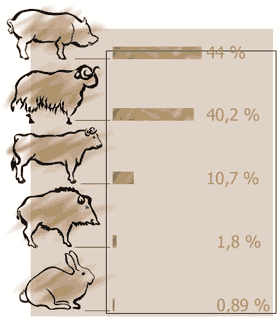- Home
- Artisans and farmers
- Animal husbandry
Excavations at Entremont have yielded numerous animal bones that provide information concerning the species hunted and the raising and management of livestock.
Most of the animal bones found at Entremont correspond to the remains of meals, but some also to tabletterie. Half of the pigs consumed were slaughtered at the young age of one and a half years. The cattle were small in size, which is common in contemporary Gallic sites. The sheep and goats were slaughtered when they were at least eight months old. While we do not have evidence for the consumption of dog or fox at Entremont, we know that it is attested at other sites in southern Gaul at the end of the Iron Age.
The age at which goats were slaughtered shows that wool and milk, in addition to meat, were desired products. This is also attested by the presence of spindle whorls and cheese baskets.
The consumption of animals by the Gauls of Entremont according to the animal bones found on the site.
A taste for pork
While at other sites beef was primarily consumed, the inhabitants of Entremont ate four times more pork. We also observe that the posterior limbs of pigs are more frequent than anterior ones. Does this tell us that hams were imported, or that pork shoulders were sold?
We can thus observe the originality of the alimentary habits of the inhabitants of this site relative to those at other sites of the Salyen confederation, or of other neighboring sites such as those at Berre Pond. But is this originality representative of the influence of Marseilles, or of an aristocracy whose elitist gastronomic tastes influenced the rest of the population?
Despite the proximity of the country and the sea, hunting and fishing left few traces in the alimentary remains of these cavalry warriors and farmers. Did they distance themselves from traditional rural practices, or was this a consequence of warring times?
